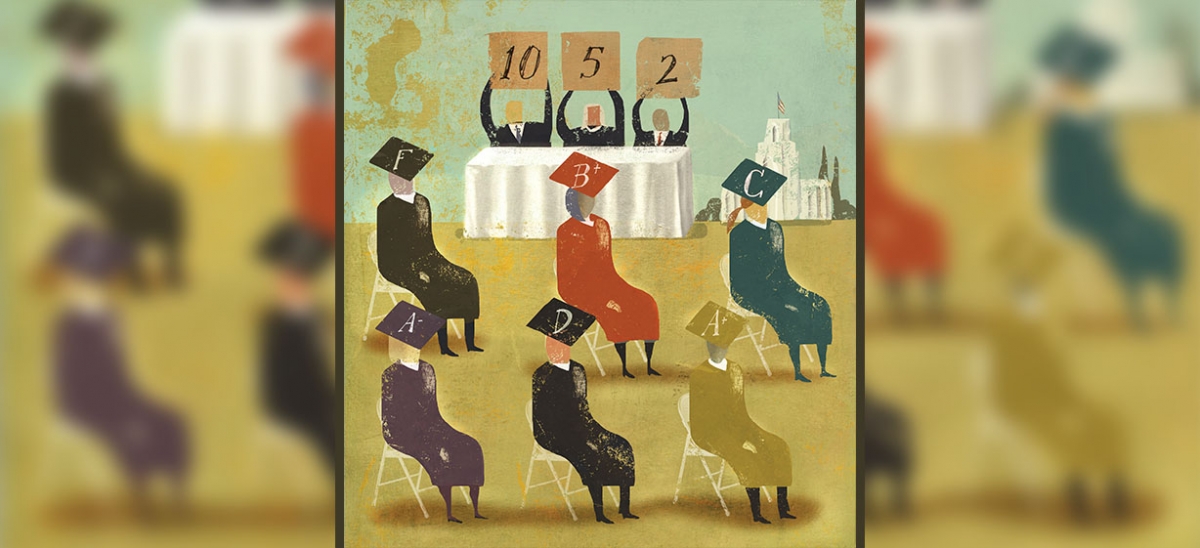Grading the Scorecard

Although Sarah Twing showed diverse talents in high school in Penn Laird, Va., she knew her passions would need to be tempered by financial considerations as she looked toward college. Originally from Uzbekistan, her adoptive parents agreed to pay half of her college tuition. The other half would rest on her shoulders. Those who were close to her urged her to think about careers that would lead toward financial independence, even wealth. Sarah should consider medical school or an MBA, they told her.
Sarah was unsure, though. Was medical school really right for her? Did she see herself as a business mogul 25 years into the future?
Sarah’s high school grades and test scores were good enough to get her into prestigious institutions all over the country. Allegheny College in Meadville, Pa., seemed like a particularly good choice for a young woman hoping to find what she was really meant to be. But Allegheny isn’t cheap. Even with the help from her parents, she expected to accrue tens of thousands of dollars in debt over four years. So she had a difficult financial situation ahead.
And she wasn’t alone.
The college graduating class of 2013 in the U.S. faces more than twice the debt its peers faced two decades ago, according to an inflation-adjusted analysis by the student services company, Edvisors. The firm found that the average graduating college senior today has about $30,000 in debt before they get their first paycheck after graduation. With that in mind, students such as Sarah enter college with a weighty choice: Is college a time to find oneself? Or a time to find oneself a lucrative job?
Scorecard screenshot
Questions like these inspired President Barack Obama to announce a federal “College Scorecard” in his Feb. 12 State of the Union address. The Scorecard pledged to make colleges more transparent and more forthcoming with what they charge and deliver. For the students who were OK with taking on debt, the Scorecard would show how much debt they could expect. It would also help them minimize their college tab if possible, and find fair, affordable options for where to study after high school, the president said.
In concrete terms, that meant the White House would now provide a search engine for colleges—a website similar to the U.S. Department of Education’s College Navigator site, or other online college databases hosted by media outlets such as U.S. News and World Report, or private websites such as Peterson’s.
The White House’s offering promised to be slightly different than those services, however. And when the Scorecard was revealed, its uniqueness—or at least its attempt at uniqueness—became clear in two ways.
First, the Scorecard is designed to be simple. The site’s landing page asks prospective students to choose a location, a college type, an area of interest, or a popular criterion. Then, by prompting students with basic follow-up questions, it helps narrow options. Once a student picks an institution, the Scorecard provides data about costs, graduation rates, loan default rates and amounts borrowed for every degree-granting institution in the nation.
Second, the Scorecard promises to provide information about jobs. “What kinds of jobs do students have when they graduate?” the site asks. Unfortunately, the Scorecard can’t yet answer that question. As the site explains, “The U.S. Department of Education is working to provide information about the average earnings of former undergraduate students….”
That’s a more complicated project than it may appear to be. And some colleges in western Pennsylvania are concerned that merely providing earnings information might paint some excellent schools in a questionably unflattering light.
The local state of affairs
hile the DOE decides what information will be gathered for the Scorecard’s jobs section, many local schools are paying more attention to students’ career options, hoping to improve post-graduation job numbers without having to be asked to do so by the federal government.
Although Bill Campbell stopped short of saying the Scorecard caused Chatham University to completely rethink its approach to career services, the Pittsburgh school’s vice president of marketing and communications said it’s no secret that universities are paying more attention to employment options after school. The Great Recession made students more aware that a college diploma alone isn’t enough to land a job.
Still, he said, students need to be pushed occasionally. “Too many students start thinking about their careers the spring semester of their senior year. So they come into the career services center panicked, and say, ‘I gotta get a job, can you help me?’ ”
The solution, he said, is that schools such as Chatham now push students more aggressively toward internships and working outside the classroom. Chatham, in fact, now has a two-internship requirement for most of its majors. “That gets them thinking about life after school.”
Waynesburg University takes a similar approach.
“We’ve been focusing on department showcase days in the summer,” said Robin King, senior vice president for enrollment and university relations. “If someone wants to study criminal justice, we have [Crime Scene Investigation] camps where we can put students in the field, working with professionals to understand what the field of study is like. It provides true awareness. It shows them what they’re going to be doing when they graduate, hopefully.”
And for many schools, that’s exactly what their students want.
“The focus here is definitely about getting a job,” said Renée Starek, director of the Career and Professional Development Center at Seton Hill University.
It’s an important point. There are schools that seem to be better equipped to usher students quickly into post-graduate jobs than others. Starek said internships are part of the reason why Seton Hill is considered good for finding a job after school. Plus, there are other perks. Seton Hill is one of a select few universities nationwide to issue iPads and other electronic devices to incoming students. The goal, Starek said, is to ensure students are able to effectively use mobile technology. Because of that, Starek isn’t too worried about the Scorecard’s influence on Seton Hill going forward.
Neither is Wendy Beckemeyer, vice president of enrollment and financial aid at Robert Morris University. “I think that our history as being a top-notch business program puts us in a really good spot,” she said. “No matter what they’re studying, students know—and their parents know—that they’re going to get some business acumen in every discipline. That’s our history, our background.”
Point Park University President Paul Hennigan considers his downtown Pittsburgh university in the same situation. “We’re going to look great [on the Scorecard]. But I worry about schools that don’t put the kind of emphasis on jobs that we do.”
The problem with standardization
How does a governing body measure the emphasis a university puts on finding jobs after graduation? Looking at how many students are employed when they graduate would be one metric. But as Waynesburg’s Robin King points out, collecting that information mostly relies on how many students are willing to keep in contact with the university after they graduate. Do students reply to surveys in the mail, via email or on Facebook? What if they don’t respond at all? “You could have a [job] placement rate at 100 percent, but no one will know unless you keep in touch with students over time.”
Some colleges say that’s possible. Robert Morris University keeps a detailed Graduate Survey Report every year. Community College of Allegheny County does, too.
“It’s easy enough to do an Internet search and find where most of your students have ended up,” said Kevin Smay, director of planning and research for CCAC. CCAC keeps track of whether students are well prepared when they leave the community college, what their earnings are, whether they’re working full time, and more. “The challenge is getting everyone to use the same currency to aggregate this information.”
The National Association of Colleges and Employers is working on setting standards. But it’s no small task. In a blog post, NACE’s director of strategic and foundation research, Edwin W. Koc, wrote that “there is a serious methodological problem” in developing those standards. “The proposed government databases do not cover all students who will obtain employment.” Which means, for example, that “if a large number of a school’s graduates work out-of-state, that information will not be captured. The school’s overall comparative employment rate will suffer, and there is a good chance that the average compensation connected with the school or an individual program will also be inaccurate.”
And that’s just one piece of the Scorecard problem that’s yet unsolved.
A personal investment
Going to college is a bit like buying a home,” said Chatham’s Campbell. “It’s fraught with consequences.” Furthermore, he said, “there are so many different sites that aim to do basically the same thing as the Scorecard, it’s a bit of information overload.” And some schools simply don’t put as much emphasis on getting a job immediately after school. “If someone spends two years at Chatham and then graduates and goes to graduate school, did Chatham fail? The problem with the Scorecard at this point—or at least from what we know about how it’s being developed—is that if your placement rates are low, you’re going to look like a bad school. And that’s just not always the case. So there needs to be some nuance as they develop the Scorecard further.”
At Allegheny College, for example, about 45 percent of the school’s graduates enter the job market, according to Michaeline Shuman, director of career services and pre-law advisor. That figure is comparatively low in western Pennsylvania. It’s only a few percentage points higher than the job placement rate at A.W. Beattie Career Center—a trade school designed as an elective option for public high school students grade 10 and up in the north Allegheny County region. (In addition to landing 42 percent of its students in jobs after high school, it also sends another 43 percent of its students to college and about 6 percent to the military, according to executive director Eric Heasley.)
Waynesburg’s job placement rate is about 81 percent. Robert Morris is close to 90 percent. Washington and Jefferson College is at 92 percent.
But at Allegheny, about 45 percent of graduating seniors head to graduate or professional schools. And about 10 percent choose long-term service, such as the Peace Corps, Teach for America or Americorps as their first destination after graduation.
“That gets back to return on investment,” Shuman said. “I mean, [going into the Peace Corps] is a hard sell. You just dropped $200,000 on an education, and now you’re telling yourself or telling your parents that you’re going to go to the Peace Corps and make nothing. But we encourage it. We think it helps to make better rounded people who are going to be more able to master much more in their lives after they have that experience.”
Terry Bensel, associate provost at Allegheny, said the Scorecard needs to take those factors into consideration. It “really oversimplifies what college outcomes are desirable. I’m not opposed to the idea completely—these kinds of indicators can be useful tools—but the Scorecard will not be a cure-all. It really takes a very complicated decision and distills it down to a handful of important statistics that defy that kind of oversimplification. I worry that, taken out of context, they’ll hurt schools less focused on job placement rates. What gives me pause is that it’s possible to imagine that schools might begin to change the way they recruit students or the kinds of students they recruit if [the Scorecard] is found to be increasingly important.
“If the only metric we care about is what you do and how much you make, I think we’re moving in the wrong direction. I have nothing against students making a lot of money. But the analogy to me is that it’s like if restaurants had a scorecard that measured the amount of calories per dollar. But when you go out to eat, you’re not always looking to get the most calories for your money, are you?”
Point Park’s Hennigan agrees. “To me, every school is different, and every school has a different mission. We tend to measure our success on the ability to graduate and get work. That’s what we’re all about. But not every school is totally focused on having their students get jobs immediately after school.”
“The average person switches jobs between six and nine times in their lifetimes,” says Tori Haring-Smith, president of Washington and Jefferson College in Washington, Pa. “And that’s careers, not jobs. So how do you prepare someone to do that? How do you prepare someone to go from being a lawyer to being a journalist to being a professor to being a financial analyst? You need to give them a basic education and basic problem-solving skills. Those are all parts of a liberal arts education. A liberal arts and sciences education is the most pragmatic education one can get because it teaches the flexibility of mind that prepares you well for your first job and for a lifetime of jobs.”
Sarah Twing agrees with that. As a graduating senior, she’s accrued more than $65,000 in debt. Despite that, she didn’t decide to major in business, or computer science, or any other major that might guarantee a lucrative job after graduation. Instead she majored in international studies with a focus on the Middle East and North Africa—a degree she said would help her to do what she really wants to do: travel the world and help people. She joined the Peace Corps and will begin as a volunteer in the Dominican Republic this fall.
“I see [my debt] as part of an investment I needed to make,” she said. “I have focus now. I know what I want to do. And I don’t know that I would’ve been able to do that in any other way.”
Where to look on the web:
naceweb.org; careeronestop.org; nces.ed.gov/ipeds; collegeresults.org; https://www.rmu.edu/why-rmu/campus-experience/cpdc; cew.georgetown.edu/whatsitworth




